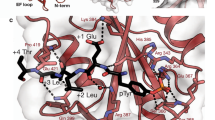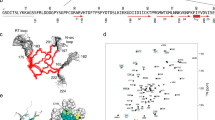Abstract
SAP (or SH2D1A), an adaptor-like molecule expressed in immune cells, is composed almost exclusively of a Src homology 2 (SH2) domain1,2,3,4. In humans, SAP is mutated and either absent or non-functional in X-linked lymphoproliferative (XLP) syndrome, a disease characterized by an inappropriate response to Epstein-Barr virus (EBV) infection5. Through its SH2 domain, SAP associates with tyrosines in the cytoplasmic domain of the SLAM family of immune cell receptors, and is absolutely required for the function of these receptors1,6,7,8,9,10. This property results from the ability of SAP to promote the selective recruitment and activation of FynT, a cytoplasmic Src-related protein tyrosine kinase (PTK)8. Here, we demonstrate that SAP operates in this pathway by binding to the SH3 domain of FynT, through a second region in the SAP SH2 domain distinct from the phosphotyrosine-binding motif. We demonstrate that this interaction is essential for SAP-mediated signalling in T cells, and for the capacity of SAP to modulate immune cell function. These observations characterize a biologically important signalling mechanism in which an adaptor molecule composed only of an SH2 domain links a receptor devoid of intrinsic catalytic activity to the kinase required for its function.
This is a preview of subscription content, access via your institution
Access options
Subscribe to this journal
Receive 12 print issues and online access
$209.00 per year
only $17.42 per issue
Buy this article
- Purchase on Springer Link
- Instant access to full article PDF
Prices may be subject to local taxes which are calculated during checkout





Similar content being viewed by others
References
Sayos, J. et al. The X-linked lymphoproliferative-disease gene product SAP regulates signals induced through the co-receptor SLAM. Nature 395, 462–469 (1998).
Coffey, A.ˇJ. et al. Host response to EBV infection in X-linked lymphoproliferative disease results from mutations in an SH2-domain encoding gene. Nature Genet. 20, 129–135 (1998).
Nichols, K.ˇE. et al. Inactivating mutations in an SH2 domain-encoding gene in X-linked lymphoproliferative syndrome. Proc. Natl Acad. Sci. USA 95, 13765–13770 (1998).
Veillette, A. The SAP family: a new class of adaptor-like molecules that regulates immune cell functions. Sci. STKE. 2002, E8 (2002).
Morra, M. et al. X-linked lymphoproliferative disease: a progressive immunodeficiency. Annu. Rev. Immunol. 19, 657–682 (2001).
Parolini, S. et al. X-linked lymphoproliferative disease. 2B4 molecules displaying inhibitory rather than activating function are responsible for the inability of natural killer cells to kill Epstein-Barr virus-infected cells. J. Exp. Med. 192, 337–346 (2000).
Bottino, C. et al. NTB-A, a novel SH2D1A-associated surface molecule contributing to the inability of natural killer cells to kill Epstein-Barr virus-infected B cells in X-linked lymphoproliferative disease. J. Exp. Med. 194, 235–246 (2001).
Latour, S. et al. Regulation of SLAM-mediated signal transduction by SAP, the X-linked lymphoproliferative gene product. Nature Immunol. 2, 681–690 (2001).
Tangye, S.ˇG., Phillips, J.ˇH., Lanier, L.ˇL. & Nichols, K.ˇE. Functional requirement for SAP in 2B4-mediated activation of human natural killer cells as revealed by the X-linked lymphoproliferative syndrome. J. Immunol. 165, 2932–2936 (2000).
Tangye, S.ˇG. et al. Cutting edge: human 2B4, an activating NK cell receptor, recruits the protein tyrosine phosphatase SHP-2 and the adaptor signaling protein SAP. J. Immunol. 162, 6981–6985 (1999).
Wu, C. et al. SAP controls T cell responses to virus and terminal differentiation of TH2 cells. Nature Immunol. 2, 410–414 (2001).
Czar, M.ˇJ. et al. Altered lymphocyte responses and cytokine production in mice deficient in the X-linked lymphoproliferative disease gene SH2D1A/DSHP/SAP. Proc. Natl Acad. Sci. USA 98, 7449–7454 (2001).
Mikhalap, S.ˇV. et al. CDw150 associates with src-homology 2-containing inositol phosphatase and modulates CD95-mediated apoptosis. J. Immunol. 162, 5719–5727 (1999).
Sicheri, F. & Kuriyan, J. Structures of Src-family tyrosine kinases. Curr. Opin. Struct. Biol. 7, 777–785 (1997).
Thompson, A.ˇD. et al. EAT-2 is a novel SH2 domain containing protein that is up regulated by Ewing's sarcoma EWS/FLI1 fusion gene. Oncogene 13, 2649–2658 (1996).
Poy, F. et al. Crystal structures of the XLP protein SAP reveal a class of SH2 domains with extended, phosphotyrosine-independent sequence recognition. Mol. Cell 4, 555–561 (1999).
Li, S.ˇC. et al. Novel mode of ligand binding by the SH2 domain of the human XLP disease gene product SAP/SH2D1A. Curr. Biol. 9, 1355–1362 (1999).
Hwang, P.ˇM. et al. A “three-pronged” binding mechanism for the SAP/SH2D1A SH2 domain: structural basis and relevance to the XLP syndrome. EMBO J. 21, 314–323 (2002).
Rotin, D. et al. SH2 domains prevent tyrosine dephosphorylation of the EGF receptor: identification of Tyr992 as the high-affinity binding site for SH2 domains of phospholipase C gamma. EMBO J. 11, 559–567 (1992).
Yu, J. et al. Synergistic regulation of immunoreceptor signaling by slp-76-related adaptor clnk and serine/threonine protein kinase hpk-1. Mol. Cell Biol. 21, 6102–6112 (2001).
Moarefi, I. et al. Activation of the Src-family tyrosine kinase Hck by SH3 domain displacement. Nature 385, 650–653 (1997).
Lerner, E.ˇC. & Smithgall, T.ˇE. SH3-dependent stimulation of Src-family kinase autophosphorylation without tail release from the SH2 domain in vivo. Nature Struct. Biol. 9, 365–369 (2002).
Anafi, M., Rosen, M.ˇK., Gish, G.ˇD., Kay, L.ˇE. & Pawson, T. A potential SH3 domain-binding site in the Crk SH2 domain. J. Biol. Chem. 271, 21365–21374 (1996).
Abraham, N., Miceli, M.ˇC., Parnes, J.ˇR. & Veillette, A. Enhancement of T-cell responsiveness by the lymphocyte-specific tyrosine protein kinase p56lck. Nature 350, 62–66 (1991).
Latour, S., Fournel, M. & Veillette, A. Regulation of T-cell antigen receptor signalling by Syk tyrosine protein kinase. Mol. Cell. Biol. 17, 4434–4441 (1997).
Davidson, D., Chow, L.ˇM., Fournel, M. & Veillette, A. Differential regulation of T cell antigen responsiveness by isoforms of the src-related tyrosine protein kinase p59fyn. J. Exp. Med. 175, 1483–1492 (1992).
Cloutier, J.ˇF. & Veillette, A. Cooperative inhibition of T-cell antigen receptor signaling by a complex between a kinase and a phosphatase. J. Exp. Med. 189, 111–121 (1999).
Gregorieff, A., Pyronnet, S., Sonenberg, N. & Veillette, A. Regulation of SOCS-1 expression by translational repression. J. Biol. Chem. 275, 21596–21604 (2000).
Veillette, A., Bookman, M.ˇA., Horak, E.ˇM. & Bolen, J.ˇB. The CD4 and CD8 T cell surface antigens are associated with the internal membrane tyrosine-protein kinase p56lck. Cell 55, 301–308 (1988).
Acknowledgements
Supported by grants from the CANVAC National Centre of Excellence, the National Cancer Institute of Canada and the Canadian Institutes of Health Research (to A.V.), the Institut National de la Santé et de la Recherche Médicale and the Association pour la Recherche sur le Cancer (France) (to S.L.). S.L. held a Fellowship from the Medical Research Council of Canada. He is now a Scientist from the Centre National de la Recherche Scientifique (France). A.V. is a Senior Investigator of the Canadian Institutes of Health Research and holds a Canada Research Chair.
Author information
Authors and Affiliations
Corresponding author
Ethics declarations
Competing interests
The authors declare no competing financial interests.
Rights and permissions
About this article
Cite this article
Latour, S., Roncagalli, R., Chen, R. et al. Binding of SAP SH2 domain to FynT SH3 domain reveals a novel mechanism of receptor signalling in immune regulation. Nat Cell Biol 5, 149–154 (2003). https://doi.org/10.1038/ncb919
Received:
Revised:
Accepted:
Published:
Issue Date:
DOI: https://doi.org/10.1038/ncb919
This article is cited by
-
Role of NKT cells in cancer immunotherapy—from bench to bed
Medical Oncology (2022)
-
NK cell recognition of hematopoietic cells by SLAM-SAP families
Cellular & Molecular Immunology (2019)
-
Interference with KCTD9 inhibits NK cell activation and ameliorates fulminant liver failure in mice
BMC Immunology (2018)
-
Hematopoietic cell transplantation for asymptomatic X-linked lymphoproliferative syndrome type 1
Allergy, Asthma & Clinical Immunology (2018)
-
Natural killer cells and tumor metastasis
Archives of Pharmacal Research (2017)



